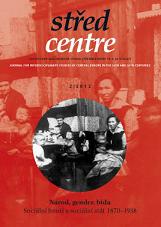Třída dělníků i žen? Proměny chápání genderových vztahů v českém dělnickém hnutí (1870-1914)
Class of Workers and Women? Changing Perspective of Gender Relations within the Czech Labor Movement 1870–1914
Author(s): Vít Strobach, Jan MarešSubject(s): History
Published by: AV ČR - Akademie věd České republiky - Masarykův ústav
Keywords: gender; working-class movement; struggle for recognition; socialist party
Summary/Abstract: Publicly manifested form of the gender order of the working-class movement on which the text focused was in 1870´s tightly bound to the political discourse and gender imagination of Czech liberal nationalists. Masculinity was defi ned by paid labor connected with the ideals of independence and breadwinning. The only disruption of separated spheres came from the liberal- nationalist feminists because of their requirement of women’s “paid labor” / “achievements” outside the factories, which was however denied (by workers). The situation did not change during the 1880´s – socialists (still) asserted an asymmetrical model of gender order which defined the imagination of separated spheres. Women had to take care of the fl at and the family, they were supposed to be “the angel in the house”. On the contrary men were responsible for protection of their wives and children, their families. Since 1890´s, with the arising of autonomous women´s organizations belonging to the socialist movement, the woman became more visible and more frequented object of the socialist discourse. Th e outlines of the gender order didn’t change much in this time, but women began to be interpelated by masculinity – this shift is evident in the examples of the feminity representations in the “gymnastic movement”. The continuous acquiring of Marxist theory transformed the understanding of women´s “paid” work. It started to be accepted as the necessary means of the (socialist) struggle for recognition. Ironically, it can be seen as the fulfilment of previous demands claimed by liberal-nationalist feminists. At this moment the impact on the coherence of imagined separated spheres was more eff ective: men´s labor lost its privileged place and women´s labor started to be equally appreciated. But masculinity and the ideal of respectable, healthy and universally harmonic man still represented the socialist movement against the deviant, eff eminate and/or androgynous (fi gures of) enemies (capitalists, politicians, factory owners etc.). At the turn of the 19th and 20th century revolutionary perspectives were replaced by reformism, but the representations of gender still emerged in the previous form. The reverse side of gradual social evolution was represented by degeneration – which symbolized the great discursive shift, i. e. the conversion of the way of thinking to the scientific, especially medical language – that could face only the healthy, symmetric and proletarian men´s bodies. It seems that for socialists there was a problem to appreciate the non-capitalist, non-bourgeois and non-masculine values. In this time also the first publics of socialist women emerged and became more visible, which have been questioning the primacy of men´s qualities and appropriated them to themselves. This can be seen as the first and most important attempt to reformulate the outlines of the gender order before World War One.
Journal: Střed. Časopis pro mezioborová studia Střední Evropy 19. a 20. století
- Issue Year: 4/2012
- Issue No: 2
- Page Range: 34-68
- Page Count: 35
- Language: Czech

